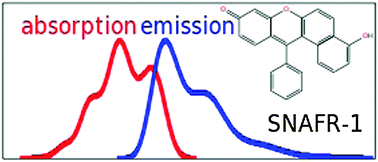Photophysical properties of NIR-emitting fluorescence probes: insights from TD-DFT†
Abstract
The complex electronic structure and spectroscopic properties of a class of six molecules behaving as near infrared (NIR) fluorescence probes, recently experimentally characterized, are investigated and rationalized using a computational protocol based on Density Functional Theory (DFT) and Time Dependent DFT (TD-DFT). These systems, all belonging to the seminaphthofluorone (SNAFR) series, are characterized by a controlled direction of annulation and regiochemistry of the ionizable moieties significantly tuning the overall absorption and emission features. Experimentally, the overall spectroscopic properties depend both on the pH and on the possible coexistence of different tautomers and regioisomers in solution, thus making the quantitative prediction of their absorption and emission features a challenging task for current ab initio approaches, due to the need for an accurate description of both ground and excited state potential energy landscapes. The results obtained in the present study illustrate the possibility of using a unique computational protocol to describe complex molecular systems in solution not only for the analysis of their intermingled spectroscopic properties but, more interestingly, for the design of new compounds for technological (white emitting

- This article is part of the themed collection: Spectroscopy and dynamics of medium-sized molecules and clusters

 Please wait while we load your content...
Please wait while we load your content...